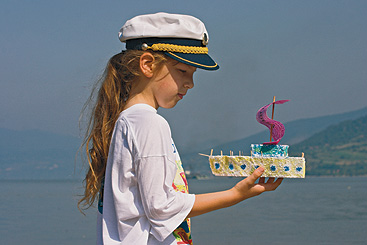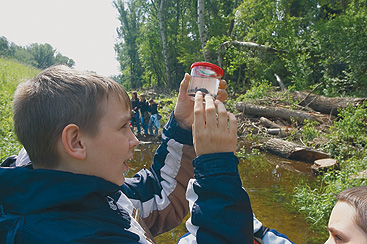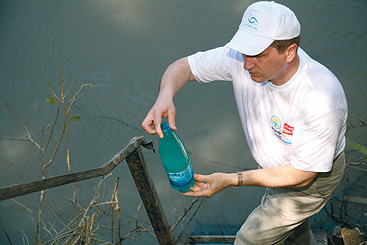Danube Day 2006: River of Life

Danube Day 2006: River of Life
Reaching audiences of several hundred thousand, Danube Day was a massive event that achieved more than ever before. The third basin-wide festival inspired change and made a real difference to the future of the rivers and the people who rely on them.

Over 1300 students were inspired to participate in this year’s Danube Art Master Competition, including these young girls from Serbia (above), the Czech Republic and Bosnia and Herzegovina (below).


Celebrations stretched across the region on June 29, 2006, to mark the 12th anniversary of the signing of the Danube River Protection Convention. Tens of thousands organised or attended over 130 events in 13 countries – 6000 people at one Moldovan-Romanian expedition alone. International ministerial events, conferences, awareness-raising festivities, river clean-ups and fun, hip youth events produced a day of celebration that entertained, educated and enthralled. Beating last year’s amazing record, over 410 organisations from government and civil society came together to make Danube Day work.
Activities ranged from public festivals in major capitals to groups of children gathered on the banks of tiny tributaries in remote rural areas. The spotlight was on the 2006 ICPDR Presidency, held by Moldova, to host Danube Day 2006: River of LifeReaching audiences of several hundred thousand, Danube Day was a massive event that achieved more than ever before. The third basin-wide festival inspired change and made a real difference to the future of the rivers and the people who rely on them.the biggest celebrations, and they achieved this and far more. Towns and villages along the Prut held events attended by environment ministers, senior international community and civil society representatives and crowds of local people in a grand Danube Week.

Schoolchildren in Austria take a close look at protecting the river in activities for Danube Day 2006.
Celebration fills the basin. Other national highlights included Romania’s week-long celebration including a key conference on international cooperation and the Danube Walk – a day of merriment, awareness-raising and dancing involving ministers, officials, NGOs, the ICPDR and Galati residents. Hungary’s festivities were widespread: on the Danube (in Baja, Báta, Budapest, Esztergom and Györ) and in the Tisza Basin. In Germany the exhibition ‘Water is the Future’ attracted a huge audience of shoppers at a major retail centre.
Serbia once again produced a tremendous affair involving 70 organisations in 20 towns, uniting the country. At Belgrade’s flagship event, guests were invited to visit 12 towns in one – exhibits presented the sights, distinctive traditions, food and rich history of almost every Serbian city on the river. While in Croatia, a fabulous day in Zlatna Greda got everyone saluting the Danube Rivers and Vukovar held a day of thanks to those who had battled against the floods of April 2006.
“Let the hearts of Europeans unite as rivers
unite, flowing into the Danube.” Pupils from
Ladce Primary School, western Slovakia,
sending their Danube greetings to everyone
celebrating Danube Day 2006.
Inspiring Danube solidarity. Danube Day motivates people to work together for the future of their environment. Cross-border activities promoted Hungarian–Serbian–Croatian stretch, the river was the uniting force for intrepid adventurers in the Baja to Apatin canoe tour. On the Moldovan–Romanian border, environment ministers Sulfina Barbu and Constantin Mhailescu cut a red ribbon on the banks of the Prut and symbolically suspended the border for the day.

Children in Slovakia find a way to bring the future of river protection within their grasp with their entry in the Danube Art Master Competition (right). The competition inspired over one thousand artworks, including this award-winning entry from Slovenia (below).

Uniting voices. Slovakia’s rivers provided the impetus for children to send ‘Danube Greetings’, messages of international goodwill to the basin. The ‘Greet the Danube’ ship blast was sounded again as workers blasted their ships’ horns in tribute to the international route that provides their livelihood. Boats from a different era united 3000 people in Austria, Slovenia, Hungary and Croatia on the Mura River when 20 traditional wooden boats travelled from Cmurek, Austria, to Novakavec, Croatia. While American Mimi Hughes had only her own strength and stamina to get through a gruelling 2950km swim along the length of the Danube, on a personal mission of social and environmental stewardship.
“Why not throw your rubbish into the river?
Everyone
else does!” The thought provoking
title
of a
Ljubljana Water Dragon artwork, created by
students from the Biotechnology
Educational
Centre to raise awareness about the way we treat
Danube Rivers.
Getting children involved. Inspiring the next generation of Danube users to act on behalf of their rivers is a cornerstone of Danube Day. This year involved more children than ever before in creative and thought-provoking activities. The ‘Danube Art Master’ competition, inviting every child in the basin to create a piece of art, elicited a huge response. In just four of the participating countries, over 1300 students entered 1000 artworks – including 550 Czech students from the Morava region alone. National winners will travel to Vienna for a two-day trip in December, courtesy of Coca-Cola and the ICPDR.
In a major youth initiative, the ‘Danube Box’ was launched, an education kit developed by the ICPDR and expert educators with support from Coca-Cola. A visually eye-catching stimulus for learning about the Danube, it is now available in 18,000 Austrian schools, with plans to launch it across the region (see article on page 11). More than 400 Regensburg youngsters were captivated by water experiments in Germany, while in Slovakia, 700 children from children’s homes took part in a packed day of activities.

ICPDR President Constantin Mihailescu collects samples for a water analysis as part of Moldova’s Danube Day week (left). Olympic champion Rita Koeban came out to celebrate Danube solidarity in a canoe tour from Baja to Apatin (below).

River of life. The Danube’s stunning wildlife was the main theme for 2006 and the basis for many events. Austria’s activities focused on capturing the imagination of youngsters with 11 safaris to the Lobau. Pupils were transported to another world: from the Vienna cityscape to an almost untouched natural haven that evoked a sense of wilderness in even the most streetwise child. In Ukraine, river adventures instilled a sense of wonder in youngsters through activities to record threatened species and search for the elusive sturgeon. In Bosnia and Herzegovina, children created artworks and learnt about river science on the riverbanks. Bulgarian pupils quizzed experts on environmental and economic problems and 300 Czech children took part in an environmental film festival. Hungary’s MusicFlow outdoor DJ festival succeeded in raising the Danube’s ‘street cred,’ popularising the Danube message to an age group often ignored in awareness campaigns.
“The past two days are worth remembering for years
to come … the extraordinary mutually constructive
initiative, enthusiasm and determination to further
build up cross border solidarity to the benefit of
both people and the river environment.”
Constantin Mihailescu, ICPDR President 2006 and
Moldovan Minister of Ecology and Natural Resources
speaking about the Moldovan–Romanian
Danube Day celebrations.
Practical actions that make a real difference. Danube Day achieves positive change. Immediate results are gained by mobilising people to undertake conservation tasks, such as 2006 clean-up days on the Danube, Prut and Delta and the introduction of rubbish collection boats in Belgrade. Long-term success is achieved through providing the impetus for officials and local people to improve river management and policies. The events of 2006 served as the catalyst for improving the integration of environmental protection into development plans (at an international conference on Danubian Institutional Cooperation in Romania); the development of Bulgaria’s flood prevention programme; the improved monitoring of the Prut; an inventory of illegal tipping areas on the Mura; and a review of the Water Quality Plan in Bosnia and Herzegovina.
“Danube Day saw high officials and ordinary people
together share a ‘no-border’ area, a common language
and the beautiful landscape.” Petruta Moisi, Eco
Counselling Centre Galati, DEF Board Member and
Speaker for the Lower Danube, speaking about the
Danube Day launch event on the Moldovan–Romanian
border.
Spreading the word. Above all, communication campaigns made the 2006 Danube Day the most successful to date. A large part of this was due to the formation of the Green Danube Partnership between the ICPDR, Coca-Cola HBC and The Coca-Cola Company. The partnership resulted in national media campaigns and support for key events.
The ICPDR would like to thank all the individuals and organisations who took part in Danube Day 2006 – the world’s largest river festival. Over 12 years of international cooperation has resulted in cleaner, safer rivers. The Danube Day partners have made a huge contribution to ensuring these improvements continue.





